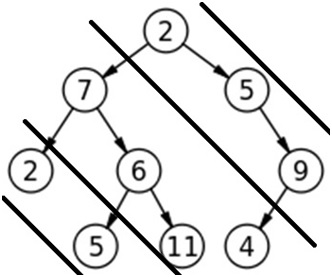Home »
Interview coding problems/challenges
Diagonal Traversal of Binary Tree
In this article, we are going to see how to print diagonal traversal of a binary tree? This problem has been featured in coding round of Amazon.
Submitted by Radib Kar, on February 20, 2019
Problem statement
Given a binary tree, print the diagonal traversal of the binary tree.
Example
Consider lines of slope -1 passing between nodes. Given a Binary Tree, print all diagonal elements in a binary tree belonging to same line.

In the above example lines of slope -1 are passed between nodes and the diagonal traversal will be: 2 5 9 7 6 11 4 2 5
Solution
Pre-requisite:
Queue q, root of binary tree, Node* temp, Node* temp1
Algorithm
The algorithm is actually processing the right children and EnQueueing the left children for each parent node. The EnQueued children accts as nodes to be processed for next level.
FUNCTION diagonalPrint(root)
EnQueue (q, root);
While (q is not empty){
temp=DeQueue(q);
Print temp->data;
temp1=temp;
While (temp1 is not NULL)
IF (temp1->left is not NULL) //if left child exists
EnQueue (q, temp1->left); //enqueue
END IF
temp1=temp1->right; //traverse to right child
IF (temp1 is not NULL)
Print temp1->data;
END IF
END While
END While
END FUNCTION
Explanation with example
Nodes are represented with their respective values for better understanding.
In main we call diagonalPrint(2)
---------------------------------------------------------
diagonalPrint(2)
q.push(2)
---------------------------------------------------------
1st iteration
temp=2
print 2
temp1=temp//2
////////////////////inner while loop////////////////////
0th iteration
temp1 is not NULL
2->left is not NULL
q.push(2->left) //7
temp1=2->right//5
Print 5
1st iteration
temp1 is not NULL//5
temp1->left is NULL
nothing to push
temp1=temp1->right //9
Print 9
2nd iteration
temp1 is not NULL//9
temp1->left is not NULL
q.push(9->left)//4
temp1=temp1->right //NULL
nothing to print
3rd iteration
temp1 NULL
exit from inner loop
////////////////////inner while loop ends////////////////////
Queue status:
7 4
---------------------------------------------------------
2nd iteration
temp=q.pop() =7
print 7
temp1=temp//7
////////////////////inner while loop////////////////////
0th iteration
temp1 is not NULL
7->left is not NULL
q.push(7->left) //2
temp1=7->right//6
Print 6
1st iteration
temp1 is not NULL//6
temp1->left is not NULL
q.push(6->left) //5
temp1=temp1->right //11
Print 11
2nd iteration
temp1 is not NULL//11
temp1->left is NULL
nothing to push
temp1=temp1->right //NULL
nothing to print
3rd iteration
temp1 NULL
exit from inner loop
////////////////////inner while loop ends////////////////////
Queue status:
4 2 5
---------------------------------------------------------
3rd iteration
temp=q.pop()=4
print 4
temp1=temp//4
////////////////////inner while loop////////////////////
0th iteration
temp1 is not NULL
4->left is NULL
Nothing to push
temp1=4->right//NULL
1st iteration
temp1 is NULL
exit from inner loop
////////////////////inner while loop ends////////////////////
Queue status:
2 5
---------------------------------------------------------
4th iteration
temp=q.pop()=2
print 2
temp1=temp//2
////////////////////inner while loop////////////////////
0th iteration
temp1 is not NULL
2->left is NULL
Nothing to push
temp1=2->right//5
Print 5
1st iteration
temp1 is not NULL//5
temp1->left is NULL
nothing to push
temp1=temp1->right //NULL
2nd iteration
temp1 NULL
exit from inner loop
////////////////////inner while loop ends////////////////////
Queue status:
Empty queue
---------------------------------------------------------
Program ends.
Hence the diagonal traversal is:
2 5 9 7 6 11 4 2 5
C++ Implementation
#include <bits/stdc++.h>
using namespace std;
// tree node is defined
class Node{
public:
int data;
Node *left;
Node *right;
};
void diagonalPrint(Node *root)
{
Node* temp,*temp1;
queue<Node*> q;
q.push(root);
while(!q.empty()){
temp=q.front();
cout<<temp->data<<" ";
q.pop();
temp1=temp;
while(temp1){
//if left child exists EnQueue
if(temp1->left)
q.push(temp1->left);
//process all right children
temp1=temp1->right;
if(temp1)
cout<<temp1->data<<" ";
}
}
}
// creating new node
Node* newnode(int data)
{
Node* node = (Node*)malloc(sizeof(Node));
node->data = data;
node->left = NULL;
node->right = NULL;
return(node);
}
int main()
{
//**same tree is builted as shown in example**
Node *root=newnode(2);
root->left= newnode(7);
root->right= newnode(5);
root->right->right=newnode(9);
root->right->right->left=newnode(4);
root->left->left=newnode(2);
root->left->right=newnode(6);
root->left->right->left=newnode(5);
root->left->right->right=newnode(11);
cout<<"Diagonal traversal of binary tree is :"<<endl;
diagonalPrint(root);
return 0;
}
Output
Diagonal traversal of binary tree is :
2 5 9 7 6 11 4 2 5
Advertisement
Advertisement